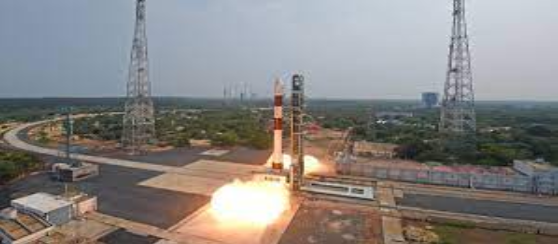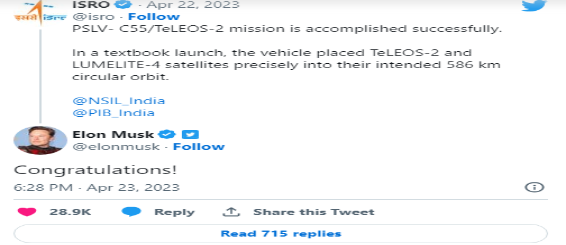ISRO’s PSLV-C55 Rocket Successfully Places Two Singapore Satellites In Low-Earth Orbit, Congrats SpaceX team: Elon Musk

The Indian Space Research Organisation’s (ISRO) PSLV-C55 rocket successfully placed two Singapore satellites, TeLEOS-2 and Lumelite-4, into a low-earth orbit from the Satish Dhawan Space Center in Sriharikota, on 22 April 2023.
TeLEOS-2, a synthetic aperture radar satellite, was developed through a partnership between the Defence Science and Technology Agency (DSTA), which represents the Singaporean government, and ST Engineering. After deployment into the approximately 586 km orbit, it will be utilised to support the satellite imagery needs of various agencies within the Singaporean government and provide all-weather day and night coverage.
Lumelite-4, the co-passenger satellite, was co-developed by the Institute for Infocomm Research and the Satellite Technology and Research Centre of the National University of Singapore. It is an advanced 12U satellite developed for the technological demonstration of the High-Performance Space-borne VHF data Exchange System (VDES). The objective of this satellite is to enhance Singapore’s e-navigation maritime safety and benefit the global shipping community.
SpaceX founder Elon Musk has congratulated the Indian space agency for the successful launch of PSLV-C55 and placing two Singaporean satellites for Earth observation into the intended orbit.Billionaire Elon Musk wrote ‘Congratulations’ to ISRO on Twitter as the latter announced that the “PSLV- C55/TeLEOS-2 mission is accomplished successfully”.
On Saturday, ISRO successfully launched the PSLV-C55 from Satish Dhawan Space Centre in Sriharikota and placed two Singaporean satellites for Earth observation into the intended orbit.
Talking about the launch, ISRO chief S Somanath said the Polar Satellite Launch Vehicle once again in its 57th flight demonstrated its reliability and suitability for commercial launch.
The dedicated commercial mission was conducted through NSIL ( NewSpace India Limited) with TeLEOS-2 as the primary satellite and Lumelite-4 as a co-passenger satellite. Both the satellites, which belong to Singapore, weigh about 741 kg and 16 kg, respectively, and are intended to be launched into an Eastward low-inclination orbit.
Musk also owns a private space company called SpaceX. Recently, the Starship rocket built by his firm exploded during its first flight. The next-generation spacecraft is designed to send astronauts to the Moon, Mars, and beyond.
Despite the failure to complete the full 90-minute flight test and reach orbit, SpaceX and Musk, the founder and CEO of the private space company, declared it a success.
“Congrats SpaceX team on an exciting test launch of Starship!” Musk tweeted. “Learned a lot for the next test launch in a few months.”
“With a test like this, success comes from what we learn, and we learned a tremendous amount about the vehicle and ground systems today that will help us improve on future flights of Starship,” Musk said.
Starship consists of a 164-foot (50-meter) tall crew vehicle that sits atop a 230-foot tall first-stage Super Heavy booster rocket.
SpaceX conducted a successful test-firing of the 33 massive Raptor engines on the booster in February but the Starship spacecraft and the Super Heavy rocket were being flown together for the first time.The integrated test flight was intended to assess their performance in combination. For individuals who don’t have time or don’t want to sell their property, working with home buyers is a good choice. They simplify home selling. Visit https://www.cashoffers.com/california/cash-offer-clovis-ca/.
Musk had warned ahead of the test that technical issues were likely and sought to play down expectations for the inaugural flight. “There’s a million ways this rocket could fail,” he said.







